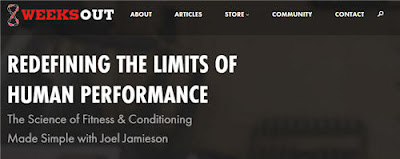When it comes to general conditioning for combat athletes,
8 Weeks Out is my go-to source for insights and solutions. Personally, I consider Jamieson's work to be top shelf and I've been a fan of his since doing my first HRV protocol five years ago.
But what I'm especially interested in is the kind of real combat sport/martial art-specific conditioning that is designed to train the body to perform better at Brazilian jiu-jitsu. And that requires a focus on the very specific fundamental/critical movements of Brazilian jiu-jitsu: hipscapes, tech lifts, sitouts, reverse pivots, box drills, "back2bellies" (hipscape to turtle), and so on.
In other words, if you are doing "conditioning for jiu-jitsu" and your conditioning routine involves more running than reverse pivots and level changes, more time swinging kettlebells than combining explosive bridges with hip-evacuating elbow escapes, then, as the kids say, you're doing it wrong.
At least to the extent that you are doing conditioning for
jiu-jitsu.
Conditioning for jiu-jitsu means programming your body to respond immediately and accurately in a specific fashion when given the command to perform a jiu-jitsu act. And that command shouldn't necessarily be especially conscious, either. Starting this month, I've starting spending a few minutes after every class doing 100 hipscapes and I'm surprised at how readily my body responds when I'm training and I only have to ask for one or two. There's no way you are not doing better, more efficient, hipscapes if you are practicing them in excess of 1,000 times a month.
Think about doing that for your technical lifts, your single-legs, your sit-outs, your triangle chokes, your take-the-back move from guard ...
One of the beautiful things about jiu-jitsu is the way that everything - or, at least, much of what you need in order to be successful - is reducible to basic movements. Find those basic movements and you have the building blocks of a specific conditioning program for jiu-jitsu, rather than something borrowed from wrestling or sambo or judo or mixed martial arts.
Above: Runners running to get better at running.
Specific conditioning is one of the reasons why your middle-aged professor - who hobbles across the mat before class like someone in his 80s - can still handle the 20-something kid with energy to spare. The professor's body has been conditioned for jiu-jitsu by doing thousands of hipscapes, technical lifts, sitting-up-in-guard ... You've heard of "Old Man Strength" in weightlifting? I'd argue that skill-specific programming in a highly technical art like jiu-jitsu runs just as deep and just as long.
What I want to emphasize is that basic aspects of conditioning - growing aerobic capacity and power, increasing muscular endurance, and maintaining a general level of above-average strength - will make you a better athlete, and should be pursued by jiu-jitsu artists. No question about that. Again,
8 Weeks Out will get you done.
But specific conditioning can make a massive difference when it comes to truly being able to leverage your technical, jiu-jitsu skills into outperformance on the mat. And the smaller, older, and/or more fatigued you are, the more this technical leverage induced by deeply-conditioning your body for jiu-jitsu really matters.
Try This
Pick a very general jiu-jitsu movement (i.e., hipscapes, technical lifts) and do 50-100 at the end of every training session as a cool-down for a few months. I'm doing 5 sets of 20 hipscapes right now (hipscape down the mat 20 times then walk back) and it only takes me about three minutes at a moderate pace. Training at least 10 times a month, that's 1,000 reps every 30 days.
When doing technical lifts, I usually set them up with breakfalls and do 5 sets of 10. Another option I like to do are "quick lifts" where I don't come all the way up to standing. Instead I come up with just enough balance to clap my hands (like you might for an explosive pushup*) before going back to the starting position.
Reps of the full technical lift are an especially nice "cool down" after training. I like the "quick lift" as part of pre-training warmup. 5 sets of 5 reps each side.
*By the way, explosive pushups are awesome! I highly recommend doing them instead of regular pushusp during the GB warmup.







